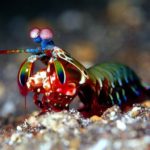Paper, Mantis shrimp–inspired organic photodetector for simultaneous hyperspectral and polarimetric imaging
The SIMPOL sensor concept was inspired by the degrees of freedom present in the stomatopod visual system. The compound eye of mantis shrimp contains spectrally selective and polarization-sensitive elements that are vertically stacked along a single optical axis. As light propagates into the stack, the mantis shrimp extracts spectral and polarization information. Analogously, the SIMPOL sensor comprises spectrally selective (the FRs) and polarization-sensitive elements (the OPVs) that are vertically stacked along a single optical axis. The spectral and polarization information is detected in a similar manner as the mantis shrimp’s eye, enabling simultaneous hyperspectral and polarimetric detection.
Learn about our two Decals!
 Click here to find out more about our Fall Bioinspired Design Decal and our Spring Bioinspired Design in Action Decal – ALL MAJORS are welcome.
Click here to find out more about our Fall Bioinspired Design Decal and our Spring Bioinspired Design in Action Decal – ALL MAJORS are welcome.Berkeley BioDesign Community
 Click here to learn about the BioD: Bio-Inspired Design @ Berkeley student organization or here to signup for more info.
Click here to learn about the BioD: Bio-Inspired Design @ Berkeley student organization or here to signup for more info.Search
Student Login




I imagine that the neurological circuits underlying these processes are governed by both 2d spacing maps with their brains as…
to reduce the impact of car accidents, it may be possible to study the force diverting physics of cockroaches to…
you see this type of head-bobbing stability in many avian creatures related to pigeons like chickens. the head ability to…
not like they taught horses how to run! this is an example of convergent evolution where both sea creatures and…
The brain functions in a similar way with neuronal connections. our brains are able to utilize the multiplicity of connections…